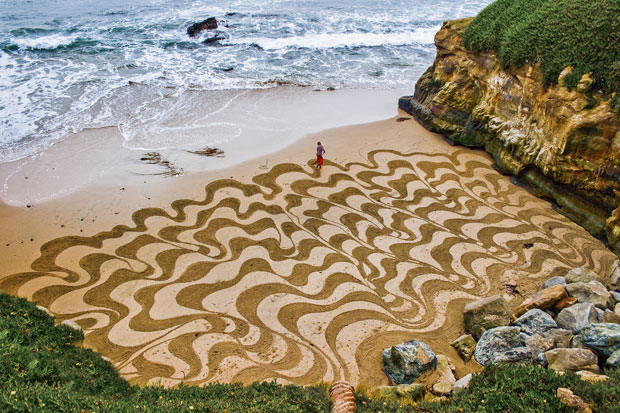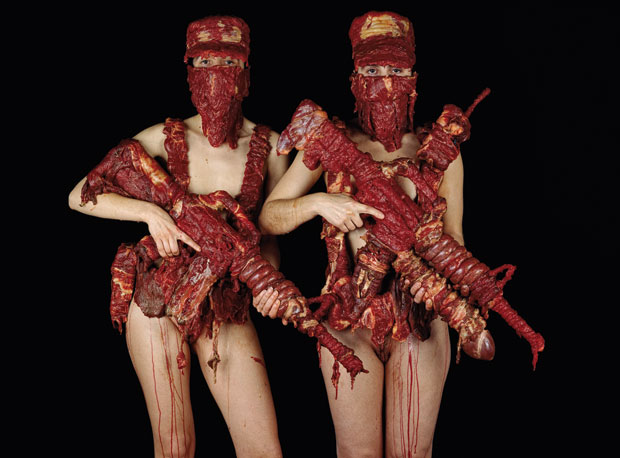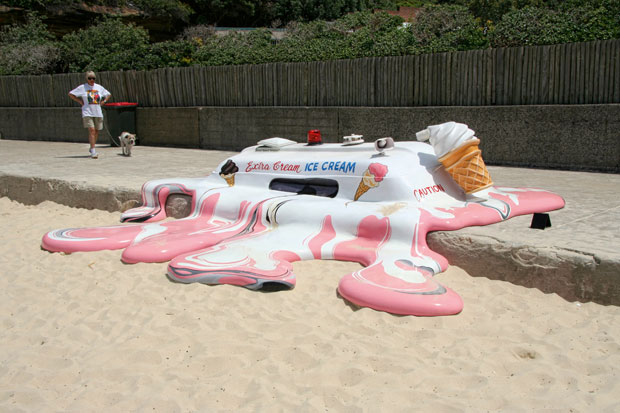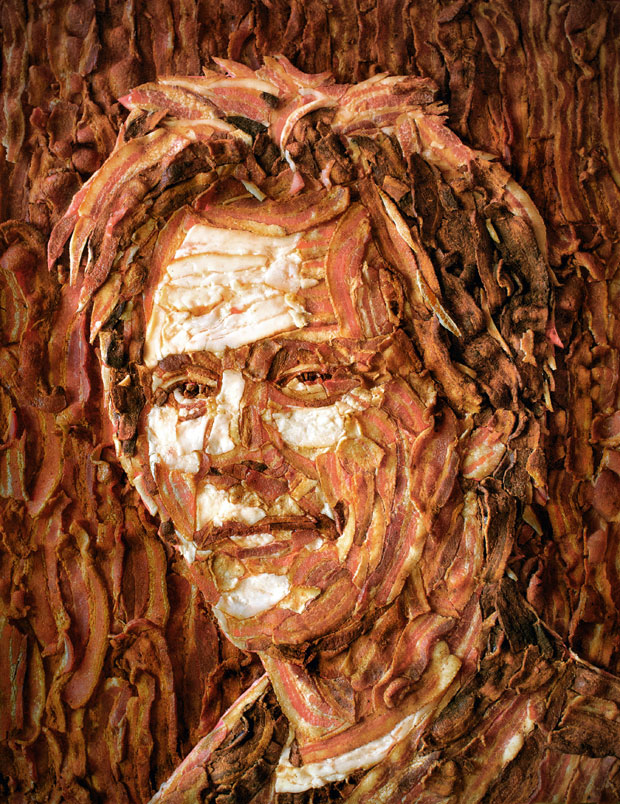
Wild Art is a visual exploration of everything and anything from outside the exclusive and rarefied spectrum of the ‘Art World’.
REVIEWS
Los Angeles Times: A walk on the wild side of art
Publishers Weekly: Wild Art review
OVERVIEW
‘Art is not always things created by people who call themselves artists’ Art critic, Barry Schwabsky
There is art, and then there is wild art. Wild art is art that is currently too offbeat, outrageous, kitsch, quirky or funky to ‘make it’ in the formal art world of galleries and museums.
From pimped cars and graffiti to extreme body art, ice sculpture, flash mobs, burlesque acts, portraits made from bottle tops, dresses made from meat, paintings made by animals, light shows, carnivals and giant artworks that can only truly be appreciated from the air, this book has them all.
Respected art experts, Carrier and Pissarro have studied alternative and underground art forms and cultures for years and have compiled the ultimate collection of creative works to challenge and engage every reader’s perception of what is and isn’t art Wild Art contains art that will appeal to an alternative kind of art audience: from skaters, surfers and club kids to environmental activists, tattoo artists, foodies and wild architects.
The 350 extraordinary artworks featured here are variously moving, funny or shocking, celebrating the beauty and art in anything and everything.
From phaidon.com:
INTRODUCING THE BOOK
This week’s fall book introduction is headed up by Jennifer Lawson, editor of one of phaidon.com’s favourite forthcoming books Wild Art. A brief explanation is, we think, called for. Wild Art is the term that best describes the vast array of art that occurs beyond the walls of the established artworld gallery system. These are forms of art that tend to escape the attention of art experts, art academics, art curators and art critics and generally, in the words of one of the book’s authors Joachim Pissaro, “fall short of catching the eyes or ears of cultural channels”. Until now.
Together with co-author David Carrier, Pissarro set out to explore this extraordinarily vast field – a kind of new cultural frontier, mostly unmapped, uncharted — and offer a sample of what might be enjoyed for anyone prepared to open their eyes – and minds. In essence Wild Art is one of many different artworlds, constituted of artists who have developed considerable skills, each in their respective media – whether it be the street, a plate of food, a pile of sand, or a block of ice. We interviewed Phaidon editor Jennifer Lawson to find out a little more about the book.

How did Wild Art come about?
The two authors Joachim Pissarro and David Carrier approached Phaidon with an idea for the book a few years ago. They’re both well-respected art historians and writers who’ve been working within the art establishment for a number of years. But together they’d come up with the idea that there was more to be explored outside the formal art establishment. Both of them teach and in their conversations with students they’d often come up against the question: why is some art deemed to be worthy of being exhibited in a gallery and given serious consideration while some is not? They wanted to explore this idea a bit further so they decided to look at 10 different areas of art outside the established art world.

It’s very timely, we look at this stuff on the internet every day, so it’s great to have two big brains finally make some sense of it all
I agree and I think it’s so important that we have two people who are such great authorities in David and Joachim to curate the selection. They’ve worked on the book for years, during which time they got additional researchers to really pin down the selection, so it really is a well thought out, curated selection of material that’s in the book. In their narrative the authors describe and discuss each piece and consider why a particular work should be viewed as art and why perhaps some forms of art haven’t made it into the established art world. They really give the project credence.

Can you give us an example?
Well someone like the street artist Banksy is obviously incredibly well known and is now thought of as being ‘within’ the art establishment, people collect his work and it’s shown in galleries – even if that’s not how he intended it to be. And yet we present in the street art chapter of the book this multitude of other artists who have been doing a similar thing to Banksy, and have been doing it longer and some might say better, but who’ve never made it. This chapter really questions why that might be – why is one person an artistic success while another isn’t?

How do you structure a book like this?
There are 10 chapters and each of them deals with a particular genre of wild art so there are chapters on street art, body art, food art, ice and sand sculpture, giant artworks, miniscule artworks, wild architecture and much more. Within each of these chapters there are 40 to 50 works that are presented and are then discussed. The point isn’t really to go into too much depth about one particular artist or one particular work; it really is to give an overview and to take a look at what’s out there. So we’ve been quite concise and pointed out where this work of art can be seen in the world and when it was created and, where possible, we’ve included quotes from the artists themselves, explaining why they wanted to create this work and what it means to them.

There is no accepted recognition for this kind of art, so Phaidon is really defining a genre here, it seems
Yes, but we’ve tried to avoid being too prescriptive or dogmatic. I think it’s important to say that we’re not disparaging in any way towards the established art world, we just really took on board Joachim and David’s view that we should be looking at everything outside that as well. Secondly, the book doesn’t hammer a viewpoint. It doesn’t say that you have to consider every work presented in the book as art. Instead, it presents all these different works and explains some of the stories behind why they were created and asks the question: shouldn’t we perhaps be considering this to be art in the way that we consider the great works that are presented in galleries or museums to be art?

Given the nature of the book we imagine the selection and editing process was a healthy mix of collaboration and artistic rigour
Of course, but there was very little taken out. In fact, most of the time the editorial process involved adding more and more content in. Once we got started on it, it really opened our eyes to the world around us and the many aesthetic creations contained within it. So there was very little arguing over anything that we really thought went too far or that shouldn’t be included, because, after all, that’s not really the nature of the book.

What was it like working with the authors?
David and Joachim were so open minded to all of our suggestions. Obviously over the course of nine months or so working on a book everyone comes up with new ideas, so this book evolved while we were still working on right up to the end especially because the authors were so actively engaged with it. I think the fact that they both still teach and lecture means they have been so engaged with this book because they’re still talking to people about it and the idea is still out there and it’s still so pertinent.

What were the things that you learned from the book?
I had never really thought about why art is art and why some art ‘makes it’ and some art doesn’t. It’s really changed the way that I view people’s artistic expression. Street art in particular has been a real awakening for me and that’s come about from working on this book. I’d never really taken it onboard before. I live in London, I’d seen it, but I’d never really paid attention to it. And now I walk past and I look at it and I can see the influences in it and I see that it’s someone’s artistic expression, so that’s really changed for me.

Can you tell us a bit about the design?
We’ve tried not to make it look overly designed. There is such a wealth of varying content in the book and we want to show it off as best we can. This is not really involved book design. It has been deliberately planned so that it suits the varied content within. It looks perhaps a little irreverent – which is certainly in keeping with a lot of the artwork – but we didn’t want something that was too constrictive, or that imposed a rigid framework on the artwork, because that’s exactly what galleries do. It’s supposed to be quite open.

Anything else that’s special about Wild Art?
Every single person who has worked on this book has ended up loving it. And also if you ask someone what their favourite work in it is everyone has a different opinion. Mine changes every day! At the moment I love the ice sculpture. The thought that people put days of work into crafting something so beautiful, in the knowledge that it’s going to melt within hours of being presented I find just amazing – that idea of you enjoy it now or it’s gone forever.

We envisage, in years to come, people saying, ‘this was the book that turned me onto art’ Was that one of the aims?
Well that’s exactly what I hope and what the authors hope. I really do believe that’s going to be the case. I think especially with young people who show some interest in art, maybe they’re good at art but they don’t yet engage with art in the traditional ways by going to a gallery or by buying a more formal book about art – this is the perfect book for them, and the way to get them into art.